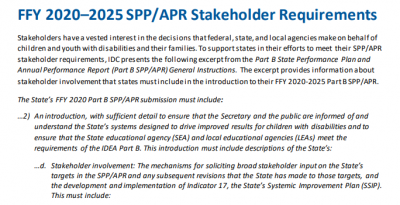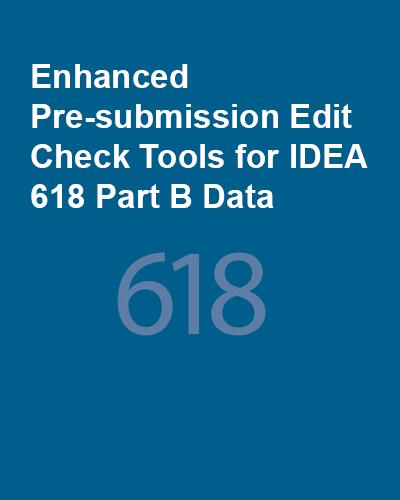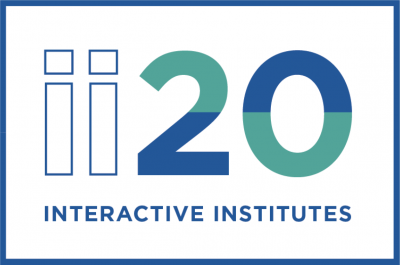
Resource Library
Guides. Briefs. Toolkits. Quick reference information. IDC and its partners created these data quality resources to help states better prepare to address their existing or emerging IDEA data quality needs. Use our search and filtering tools to navigate the library.
Resources 43 - 49 of 88
Format: Quick Reference
FFY 2020-2025 SPP/APR Stakeholder RequirementsThe FFY 2020-2025 SPP/APR shares the stakeholder requirements for the FFY 2020-2025 SPP/APR in a simple one page format. This resource can be used with state staff and other partners when planning for the SPP/APR.
Format: Applications and Spreadsheets
SEA Edit Check and Data Display Tools for IDEA 618 Part B DataIDC presents the SEA Edit Check and Data Display Tools for IDEA 618 Part B Data to help states prepare their Part B data submissions. States can use these tools to review the contents of their IDEA 618 EDFacts Part B personnel, exiting, discipline and child count and educational environment data for children ages 3–5 (FS089) and students ages 6–21 (FS002) prior to submission to the EDFacts Submission System or ESS. The tools apply edit checks and identify potential errors in subtotals or totals in the data files. In addition, the tools provide user-friendly summaries of the 618 data. The tools are enhanced versions of the SEA Edit Check and Data Display Tools for personnel, exiting, discipline, and child count and educational environment data. The main difference is the enhanced edit check tools require states to directly copy and paste the EDFacts data files they will submit to ESS as opposed to manually entering data into an Excel file in a format that is different than the one required for submission to ESS.
Format: Trainings
ii20 Session Presentations and HandoutsThe Interactive Institutes 2020 – Building and Sustaining a Culture of High-Quality Data provided opportunities for participants to take a deep dive into data quality topics to learn about data culture change. Participants were able to discover best practices to improve data collection, reporting, analysis, and use. They also engaged with peers and TA providers about trending data quality topics. Each session presented powerful ideas and actionable plans to improve work processes and data quality.
Format: Applications and Spreadsheets
Coordinated Early Intervening Services (CEIS) Fiscal and Student Data TrackerThe Coordinated Early Intervening Services (CEIS) Fiscal and Student Data Tracker is a set of four tools SEAs can use with their districts, schools, and providers to assist them in tracking the finances, services, and student data associated with CEIS. IDC and CIFR produced the CEIS Tracker. The resource also includes an instructions document or user's guide for more information about when and how to use the CEIS Tracker.
Format: Applications and Spreadsheets
SEA Edit Check and Data Display Tool - Part B MOE and CEISIDC and CIFR developed the SEA Edit Check and Data Display Tool - Part B MOE and CEIS to help states prepare their Part B MOE and CEIS data submission. States can use the tool to identify potential edit check errors or errors in subtotals or totals prior to submitting the data to OSEP. The tool allows states to input LEA-level data into the base data tab and generates edit check messages that the tool displays in the auto-calculations tab. IDC and CIFR updated the MOE and CEIS edit check tool with the revised reporting years and to reflect updates to three edit checks.
Format: Applications and Spreadsheets
Graduation Rate (Indicator 1) and Dropout Rate (Indicator 2) CalculatorThis tool from IDC and NTACT calculates graduation and dropout rates using the 618 Exiting data, as OSEP will require in coming years for reporting in states’ SPP/APRs. The tool can accumulate and graph multiple years of data, allowing users to observe trends in the rates over time and share the information easily with stakeholders.
Format: Guides and Briefs
Graduation Rate and Dropout Rate: Indicators 1 and 2 Measurement Changes From FFY 2019 to FFY 2020–2025This resource focuses on recent changes in the data source and measurement of Part B Indicators 1 and 2. The resource specifically addresses the treatment of “alternate diploma” in the new calculation. In FFY 2019, the calculation of graduation rate included students receiving an alternate diploma in the numerator. For FFY 2020–2025 the calculation of graduation rate includes students receiving an alternate diploma in the denominator. The calculation for Indicator 2 remains similar from FFY 2019 to FFY 2020–2025; however, it explicitly adds students receiving an alternate diploma in the denominator.








